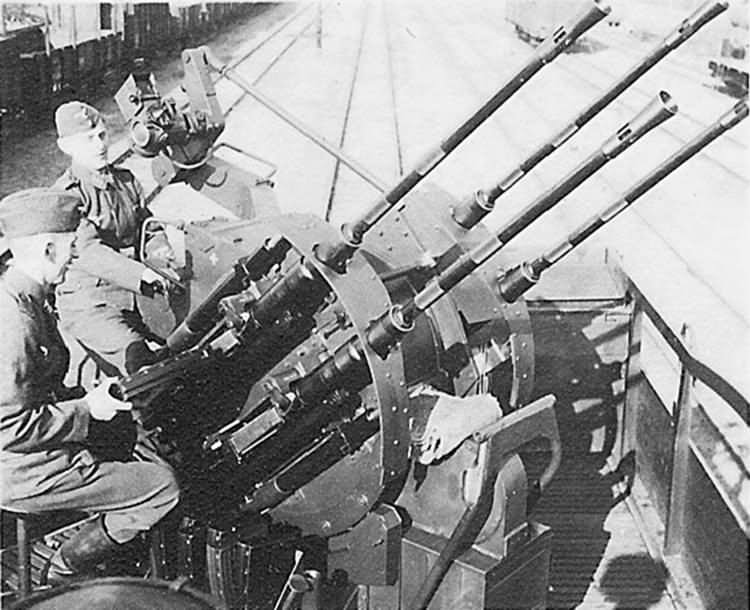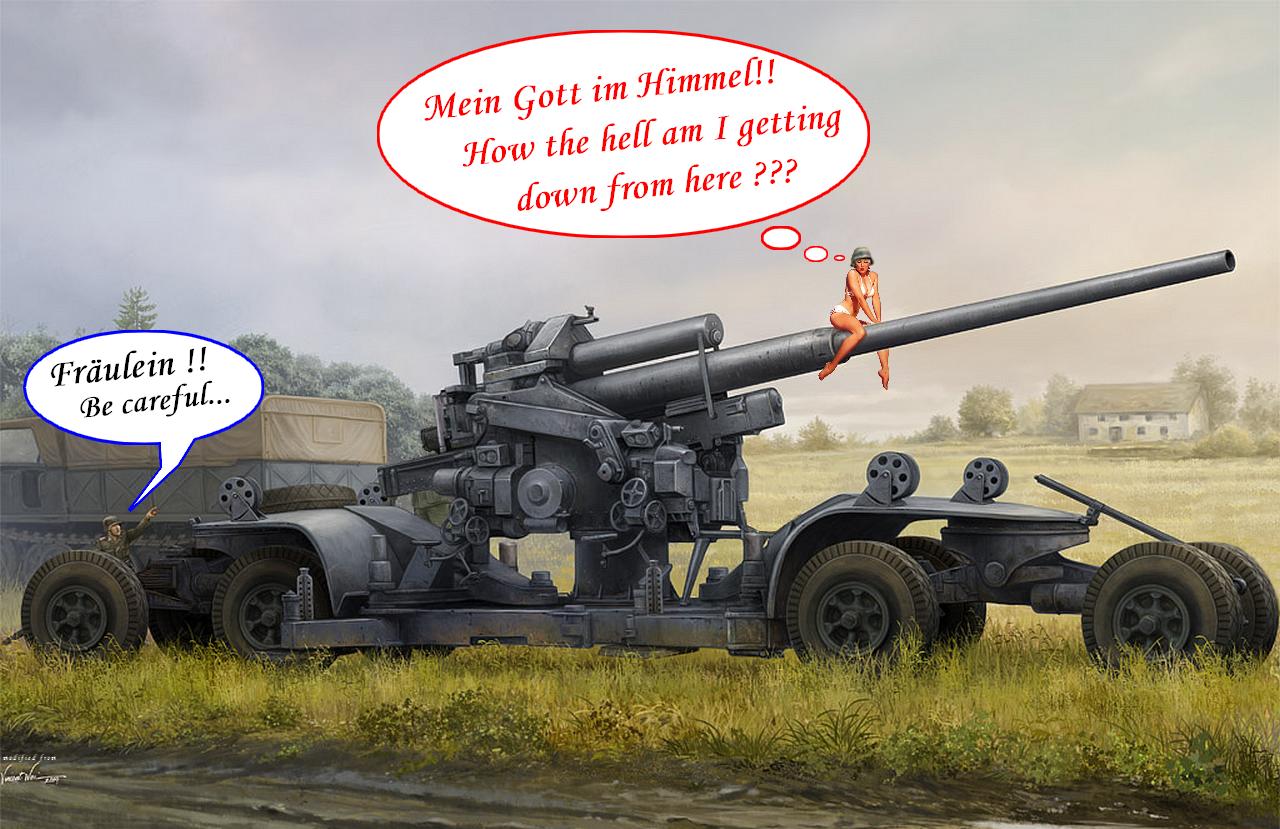When I was Volunteer working at the LA maritime museum I often would go to the library and perose the books to look for photos of something we were modeling at the time. On such a day I came across a drawing of some proposed military rail cars, one stood out to me, it was a rail car with a twin 40 mm bofors guns that seemed to be mounted on a old crane car base. I thought it would be a nice thing to make a model of . I went back to get the book but alas I could not find it. For years I though I wanted to model it but I never got the time. Now being retired I have the time and with the virus having us old geezers confined to the house I thought it would be a good time to build it. So here is what my memorie told me it looked like. Hope you like it.
Replies sorted oldest to newest
Very cool! It makes me think of a “training platform” that may have been used in gunnery training.
Tom
NICE WORK!
Nothing found on a U.S. version, but the Wehrmacht had something similar.

Gotta imagine that the think bucked like a sob, even on a crane car chassis
Wonder if the Wehrmacht prototype inspired the planned US version you read about?
We always worried about John at the club. When unsupervised, he was always building some kind of weapon, patriotic though it may be. Maybe John will post photos of his 16" Naval Gun being shipped on a flat car. Nice work, John.
Nice job John. When that thing fires it should be "self propelled"!
That's awesome. Great work!
The linc below is to Ramish Bishop's version. You may need to cut and paste the link to your browser.
Wow John, that is really unique and a great build! That would be so cool to have on a layout.
https://www.google.com/search?...rc=Tr4OGlX89bbh7M%3A
Didn't Lionel's security car caboose have twin 40's on the roof?
Outstanding!
Fantastic job!
Well done!
Peter
Excellent build!
Found these images of various others.
breezinup posted:Nothing found on a U.S. version, but the Wehrmacht had something similar.
Based on the center [ Willison ] coupler and the style of the visible truck and carbody, the flat appears to be of Russian origin, and I think it is likely that the entire car, flak and all, was originally Russian. Certainly the Germans used a lot of captured Russian materiel, including AA.
This photo may have been taken in Russia; does anyone else think the main track to the right looks like it's been narrowed on the left side ?
SZ
Very nice looking, John. The problem I see is the lone car needs company, such as 4 or 5 more. And since you are now unsupervised....lol
breezinup posted:Nothing found on a U.S. version, but the Wehrmacht had something similar.
That flatcar may well be Russian, but those guns are without doubt 88mm FLAK 36 models.
CSXJOE posted:https://www.google.com/search?...rc=Tr4OGlX89bbh7M%3A
Didn't Lionel's security car caboose have twin 40's on the roof?
More representative of twin 20s.
palallin postedThat flatcar may well be Russian, but those guns are without doubt 88mm FLAK 36 models.
That's interesting, thank you. It certainly was a neat installation or conversion -- must have been done when they were winning........
SZ
Very Good - One question - What scale are the guns and where did you get them? Thanks
Anti-aircraft gun equipped railcars were used fairly often by Germany in WWII, apparently. No doubt there were similar designs (perhaps some modeled on German prototypes) prepared by the U.S. in anticipation of possible Japanese air attacks on the West Coast.




A depressed center flatcar would be ideal to model this. Barrel "decoration" optional.



Thank you guys for your nice comments.
Answer to some questions.
The info I read at the time did not state what it was to be used for, your guess is as good as mine.
The rail stanchions are from Mega hobby
https://www.megahobby.com/categories/model-ships.html
The guns are from Shapeways. https://www.shapeways.com/mark...;s=364#more-products
They are not cheap, the twin 40 mm bofors was 95.63 bucks plus shipping, The are very good 3D printing.
The car body is a MTH railroad crane base.
I do not recognize the gun on a depressed flat car. it is not a WW2 bofors, maybe a russian toy or from a star wars toy. Not sure.
Lionel security car is a fair representation of what looks to be a bofors twin gun.
The 16" gun barrel I modeled was take from an actual 16 " naval gun which came from the Long Beach Navy yard, It is located in front of the LA maritime museum. I plan on going up to Philly and take some photos of the brackets holding the guns on the flat cars if they left them, if not I will try to use the photos to make them.
John
breezinup posted:Anti-aircraft gun equipped railcars were used fairly often by Germany in WWII, apparently. No doubt there were similar designs (perhaps some modeled on German prototypes) prepared by the U.S. in anticipation of possible Japanese air attacks on the West Coast.
Not really. During '41/'42, when there was any real possibility of serious Japanese raids against the West Coast, nothing like the necessary numbers of AA mounts was available for such uses. The USN was swallowing production whole in trying to bring the Pacific Fleet up to reasonable capability. When production finally caught up--say, by summer '45--there was not a chance at all of even a token threat. Besides, every car the RRs could get their hands on was being used to move troops, civilians, and supplies.
Fixed installation certainly have AAA capability as did critical areas of some cities, but coastal fortifications lagged behind the times, and most were never even completed. Public fear notwithstanding, there was never any serious chance--or serious intention--of Japanese invasion of continental US soil. The images of Tojo in the White House were propaganda and posturing. The Imperial Japanese Navy had nothing like the amphibious assets necessary to land and support troops on the West Coast even when they were on top of the short-lived domination of the Western Pacific. After the Battle of the Coral Sea, they couldn't even contemplate moving carrier forces toward the US--their abortive attempt at Midway and the Aleutians over-stretched their capability. It's not just a matter of planes and carriers, either: they did not have the underway replenishment capability. Even the Pearl Harbor raid relied on semi-civilian tankers.
Yamamoto's plan was to wear the US down, not take it on. And he, himself, accurately predicted it would fail.
palallin posted:breezinup posted:Anti-aircraft gun equipped railcars were used fairly often by Germany in WWII, apparently. No doubt there were similar designs (perhaps some modeled on German prototypes) prepared by the U.S. in anticipation of possible Japanese air attacks on the West Coast.
Not really. During '41/'42, when there was any real possibility of serious Japanese raids against the West Coast, nothing like the necessary numbers of AA mounts was available for such uses. The USN was swallowing production whole in trying to bring the Pacific Fleet up to reasonable capability. When production finally caught up--say, by summer '45--there was not a chance at all of even a token threat. Besides, every car the RRs could get their hands on was being used to move troops, civilians, and supplies.
Fixed installation certainly have AAA capability as did critical areas of some cities, but coastal fortifications lagged behind the times, and most were never even completed. Public fear notwithstanding, there was never any serious chance--or serious intention--of Japanese invasion of continental US soil. The images of Tojo in the White House were propaganda and posturing. The Imperial Japanese Navy had nothing like the amphibious assets necessary to land and support troops on the West Coast even when they were on top of the short-lived domination of the Western Pacific. After the Battle of the Coral Sea, they couldn't even contemplate moving carrier forces toward the US--their abortive attempt at Midway and the Aleutians over-stretched their capability. It's not just a matter of planes and carriers, either: they did not have the underway replenishment capability. Even the Pearl Harbor raid relied on semi-civilian tankers.
Yamamoto's plan was to wear the US down, not take it on. And he, himself, accurately predicted it would fail.
I'm sure that's correct, but John said in his OP that
"I came across a drawing of some proposed military rail cars, one stood out to me, it was a rail car with a twin 40 mm bofors guns that seemed to be mounted on a old crane car base..."
so apparently there was some thought given to it. As the article reference below says, after Pearl Harbor, "As the days and weeks progressed, the initial fear of imminent invasion settled into a long-term commitment to defend the harbor by every means possible. Mobile antiaircraft guns, searchlights and radars were positioned on virtually every hill and knoll overlooking the Golden Gate." This was just for San Franciso, but probably somewhat similar steps were taken in San Diego, Long Beach, Seattle, and other locations. It's not hard to imagine that mobile rail-mounted A/A cars were at least considered. Wartime steam engines operating on the West Coast were modified to be less conspicuous from the air, so at least at the early stages of the war, the possibility of aerial attack appeared to be a consideration.
https://www.nps.gov/nr/travel/.../seacoastdefense.htm
For some facinating reading, check out the history of the Japanese aerial balloon bombing attacks on the West Coast. The balloons were launched in Japan, and then floated via the prevailing winds until they were over the West Coast.
John, that is something else. I haven't been that far south, but the museum is one of the places I would like to get in my lifetime. I saw something some time back about the D-Day boats, and how they were made. They shot some of the background to the story at the museum since there is a boat there.
FASCINATING history lesson - THANKS to all for your inputs. During WW II, one of my uncles was assigned to a coastal artillery battery near Flushing Meadows, NYC. There were quite a few of those on both coasts.
Higgins boats, that's what the name of them are. I remembered about three minutes after posting. The story behind them is fascinating you want to see that.






